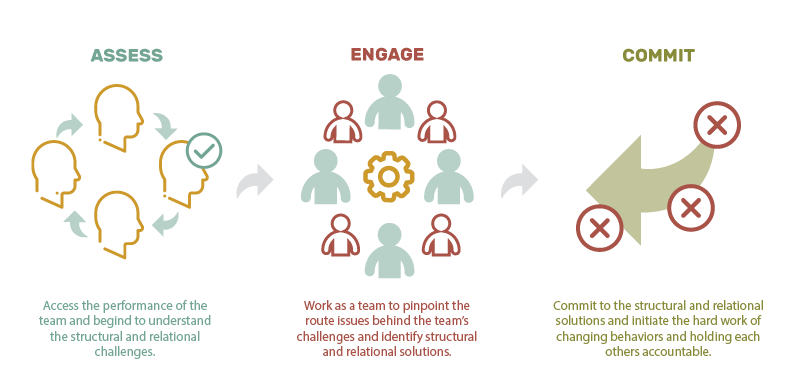Leadership Team Development
We formed RI because of our passion to unlock the potential of leaders and leadership teams and our belief that effective teamwork is a critical source of competitive advantage. Successful teams, however, do not simply happen. They require nurturing and guidance. RI’s proven, developmental approach (see graphic below) serves as an accelerator for helping leadership teams fulfill their potential as cohesive units.
Our three-phased methodology starts by helping leadership teams establish a baseline for measuring progress. We then work with teams to pinpoint the root issues that are holding them back from reaching their full potential. Finally, we drive leadership teams to commit to the structural and relational solutions necessary for building aligned teams that have impact way beyond the contributions of any individual team member.
Jack and Relationship Impact have been one of the best investments I’ve made in over 10 years since I founded Censeo. Jack has helped us build a much better team dynamic and his coaching both to me personally as well as to our team is truly helping us become more productive and up our game as a team. Thanks Jack!!!
Raj Sharma, Founder/CEO, Censeo Consulting
Below are the principles supporting our Leadership Team Development Approach
Principle 1: Development Approach
We deploy a developmental, learning oriented approach to team effectiveness. While training on specific skills such as meeting management and project planning are important, a program to train teams to be effective is insufficient. A developmental approach enables individuals and teams to learn, practice and build capacity over a period of time.Principle 2: Focus on the Team as a System
We believe that the uniqueness of our approach is in our focus on the interconnection between these two components: (1) The team as a system that has characteristics that transcend those of any of the individual members; and (2) The individual team members who play a significant role in how the team works together to achieve a common outcome.Principle 3: Balance of Structural and Relational Dynamics
Our approach focuses on the important relationship between a team’s structural and relational factors. Specifically, there is no doubt that insufficient structure can exacerbate relationships among team members. For example, misaligned incentive structures can inadvertently create competition that naturally puts pressure on relationships. On the other hand, bad relationships among team members can expose poor structural design as exemplified by a team that avoids debate about critical issues despite having well-planned meetings.Principle 4: Performance Management
We deploy a combination of intangible and tangible metrics to help teams track progress and achieve their intended objectives. At the heart of our approach to measurement is the use of a validated and proven team assessment instrument created by Team Coaching International that measures what results a team is achieving and how it is achieving them.



